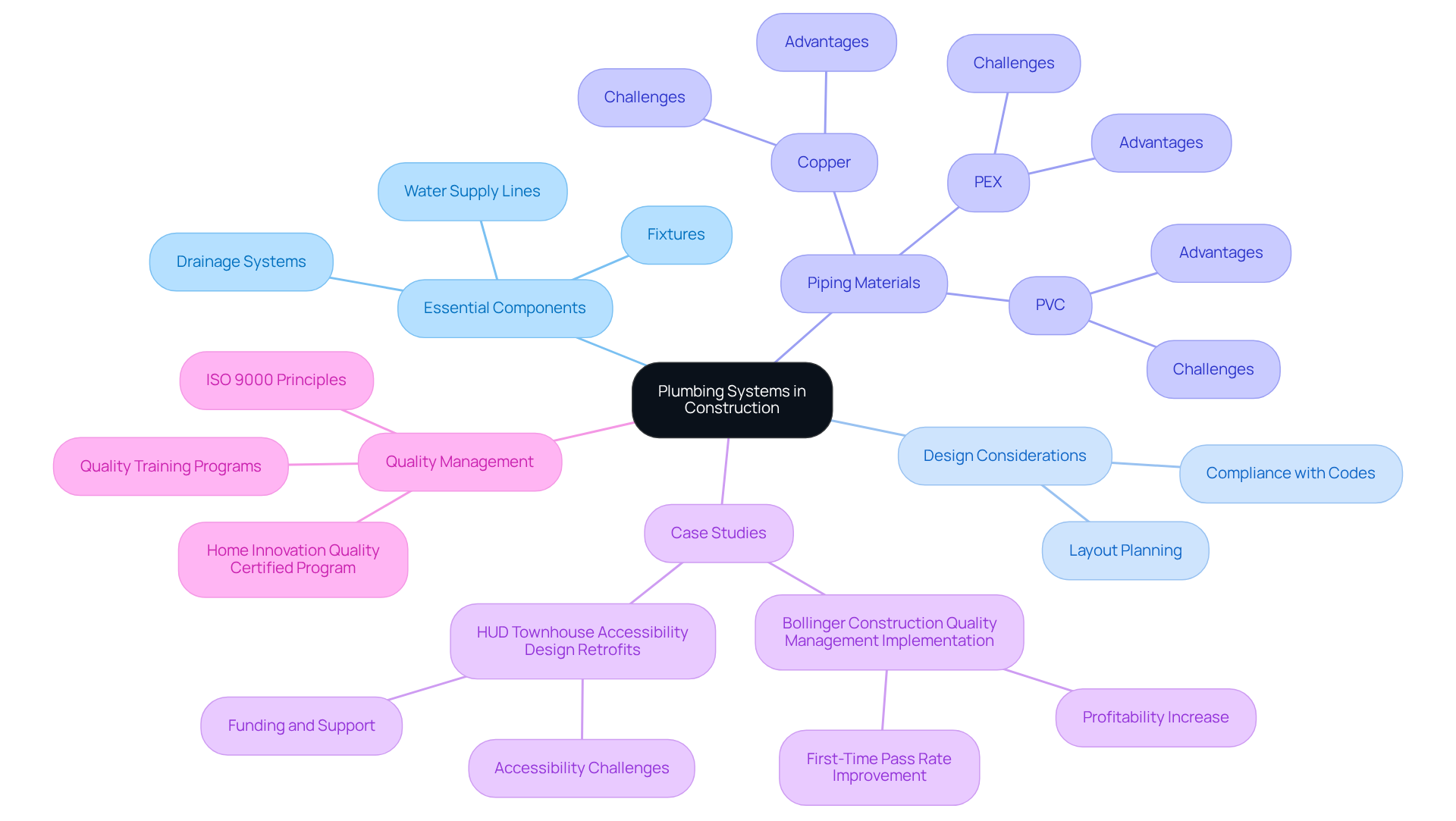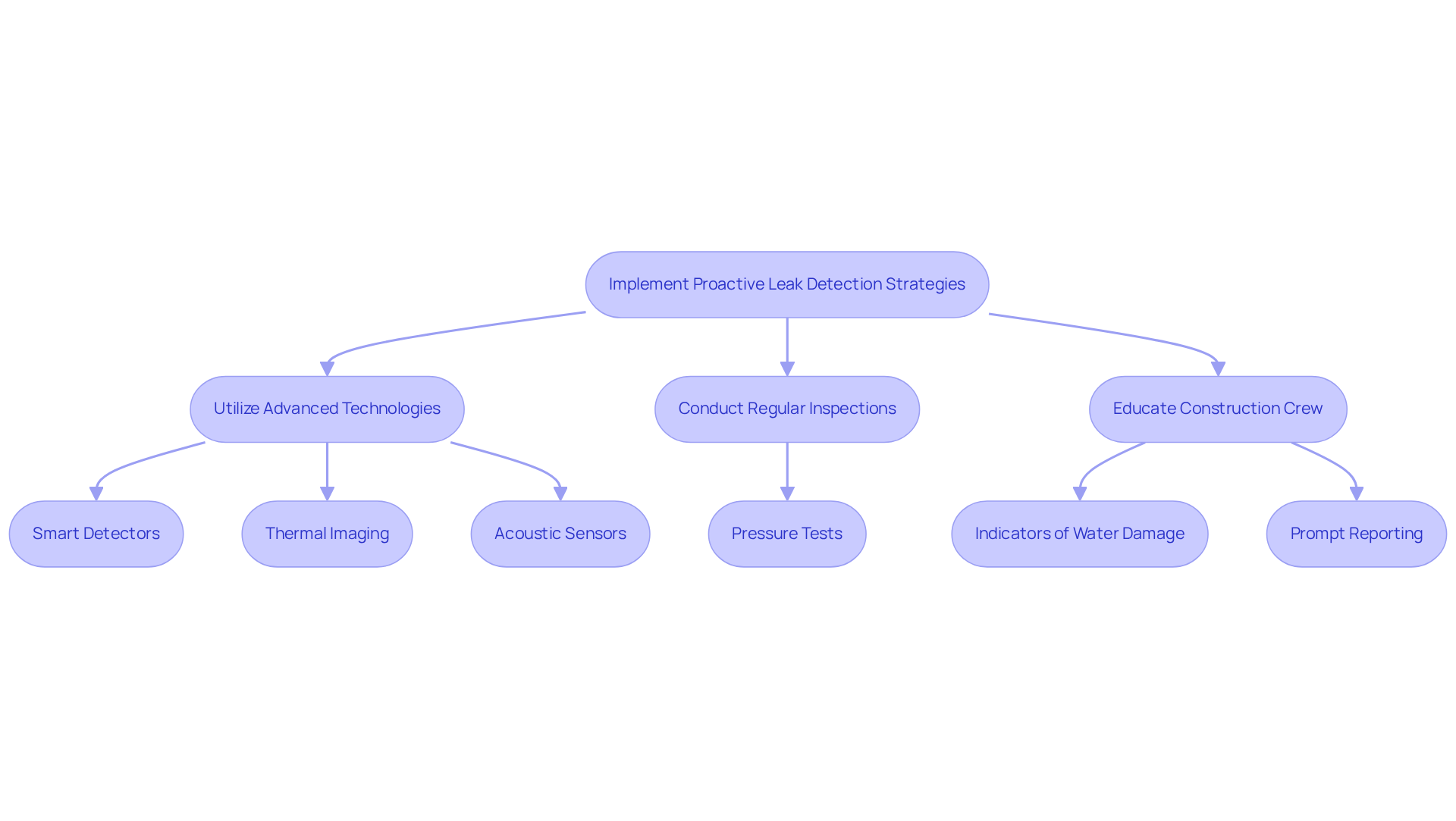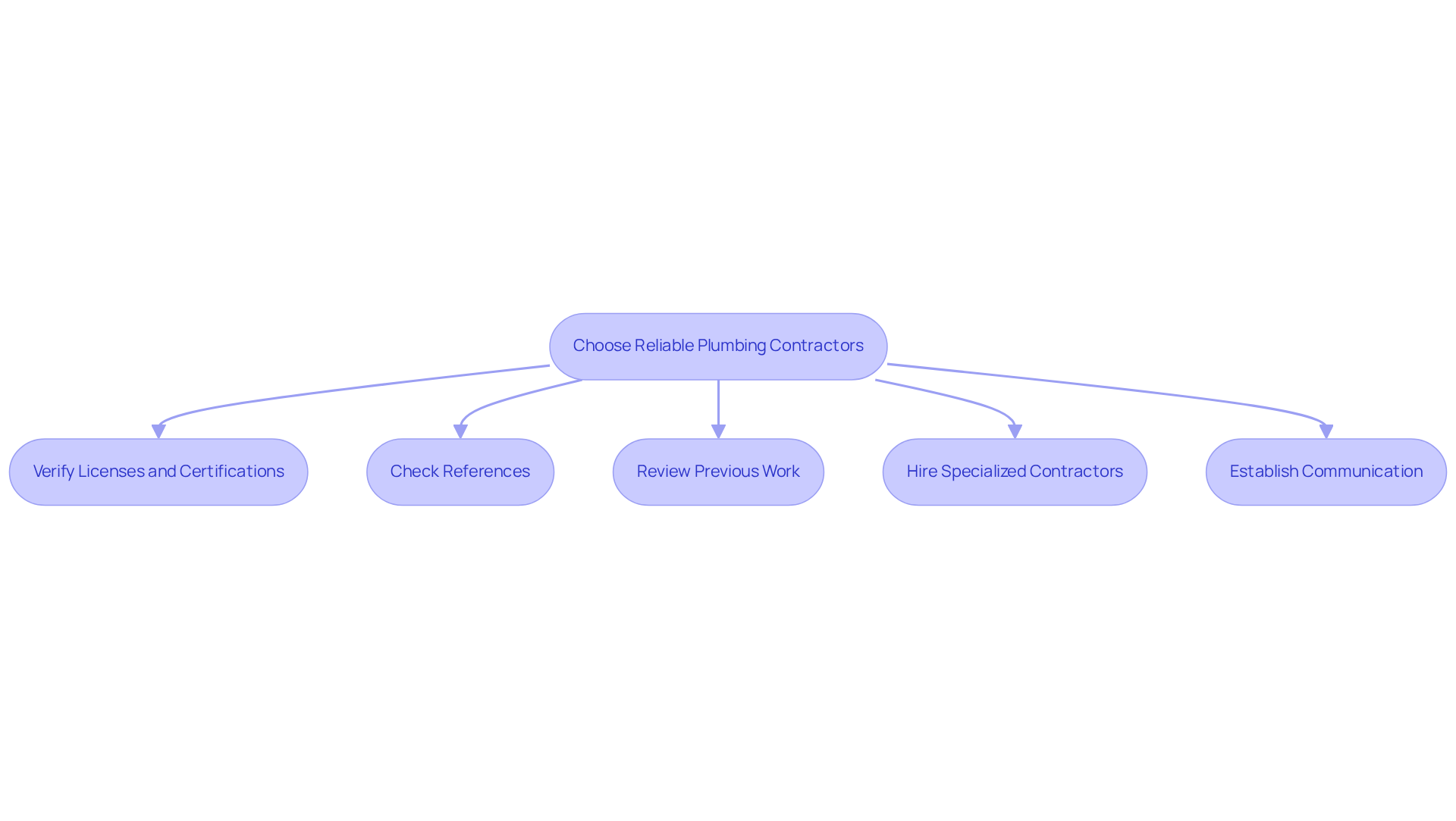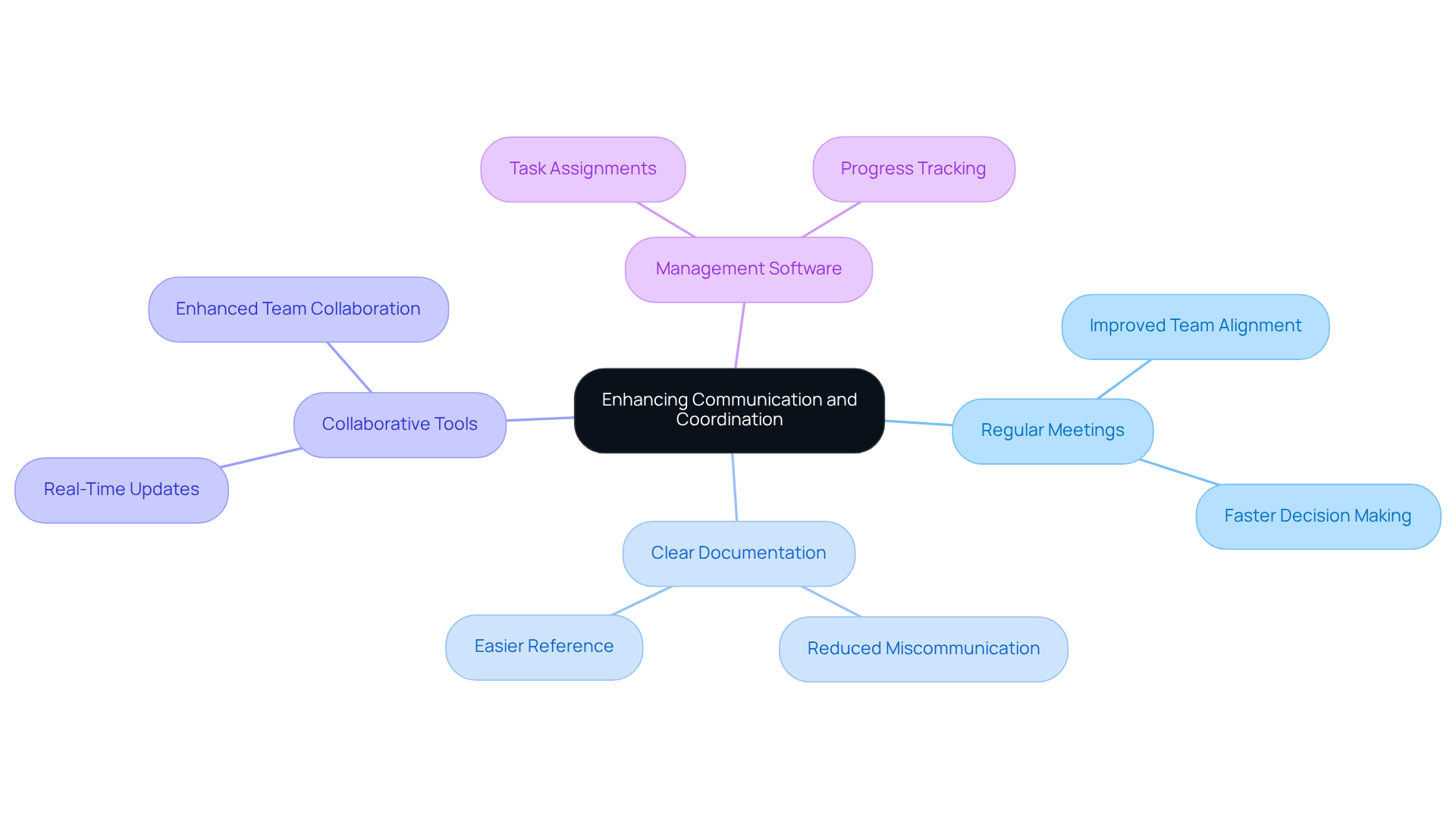Overview
This article delineates four essential practices for effective plumbing in construction projects, underscoring the critical nature of understanding waterworks, implementing proactive leak detection, selecting trustworthy contractors, and fostering enhanced communication among stakeholders. Each practice is elucidated with detailed explanations regarding its influence on project success, highlighting the necessity of proper system design, consistent maintenance, and the advantages of collaboration. Collectively, these elements contribute to heightened efficiency and superior quality in metroplex plumbing installations, ultimately driving project outcomes.
Understanding waterworks is foundational for any construction project, as it ensures that all plumbing systems are designed to function optimally. Proactive leak detection not only prevents costly repairs but also safeguards the integrity of the project. Furthermore, selecting reliable contractors is paramount; their expertise directly impacts the quality of work and adherence to timelines. In addition, enhancing communication among stakeholders fosters a collaborative environment, which is vital for addressing challenges as they arise.
The benefits of these practices cannot be overstated. Proper system design leads to fewer issues down the line, while regular maintenance ensures that plumbing systems remain in peak condition. Collaboration among all parties involved enhances problem-solving capabilities, enabling teams to work more efficiently and effectively. Ultimately, the integration of these practices results in improved project outcomes, characterized by both efficiency and quality in plumbing installations across the metroplex.
Key Highlights:
- Understanding waterworks is essential for successful construction projects, involving water supply lines, drainage systems, and fixtures.
- Effective plumbing system design requires a detailed layout that aligns with building architecture and occupant needs to avoid costly modifications.
- Knowledge of piping materials (PVC, copper, PEX) is crucial, as each has unique durability and cost advantages.
- Proactive leak detection strategies using advanced technologies can prevent major plumbing issues and extend system lifespan.
- Regular inspections and maintenance are vital for optimal plumbing system performance, emphasising the need for crew education on water damage indicators.
- Choosing reliable plumbing contractors is critical for quality assurance; verifying licences and checking references are essential steps.
- Clear communication and coordination among project stakeholders enhance teamwork and contribute to overall project success.
Introduction
Understanding the intricate plumbing systems that underpin construction projects is essential for success in the industry. Construction managers must navigate the complexities of water supply and drainage, adopting key practices that enhance efficiency and ensure compliance with evolving standards.
With high stakes involved, the challenge lies in effectively mitigating risks and ensuring quality throughout the process. This article explores four critical practices that can transform plumbing management in construction, paving the way for improved project outcomes and client satisfaction.
Understand Plumbing Systems in Construction Projects
A comprehensive understanding of waterworks is crucial for the success of construction projects, encompassing essential components such as water supply lines, drainage systems, and fixtures. Effective water system design initiates with a detailed layout that harmonizes with the building's architecture and caters to the specific needs of its occupants. For example, thoughtfully planning the positioning of pipes and fixtures during the design phase can greatly minimize the risk of expensive modifications in the future. Compliance with local construction codes and regulations is vital to ensure that water supply systems operate safely and efficiently.
Acquaintance with various piping materials—such as PVC, copper, and PEX—is indispensable, as each material offers distinct advantages and challenges concerning durability and cost-effectiveness. In 2025, the emphasis on quality design is underscored by the growing demand for efficient setups that can adapt to evolving building standards and occupant needs. The National Academy of Sciences reported that the PATH program effectively facilitated technology development and diffusion over five years, illustrating the importance of quality management in construction and piping systems.
By emphasizing these elements, construction managers can lay a solid foundation for successful installation integration, ultimately improving project results and client satisfaction. EZ Equipment Rental offers a diverse range of rental equipment, including essential tools for piping, ensuring that construction managers have the necessary resources for effective design and integration.
A notable case study exemplifying successful installation integration is the implementation of a quality management system by Bollinger Construction. Following the adoption of refined ISO 9000 principles, the company experienced a remarkable increase in its first-time pass rate with code inspectors, rising from 63% to 97%. Josh Bollinger, President of Bollinger Construction, remarked, "Profitability increased nearly 10 percent, which represented the largest increase in the company’s history." This improvement not only streamlined their piping processes but also contributed to significant financial growth. Such instances highlight the substantial impact that effective plumbing design and management, particularly metroplex plumbing, can exert on construction projects, including addressing accessibility challenges, as demonstrated in the HUD Townhouse Accessibility Design Retrofits project.

Implement Proactive Leak Detection and Repair Strategies
Implementing proactive fluid detection strategies is essential for modern construction management. By utilizing advanced technologies such as smart detectors, thermal imaging, and acoustic sensors, issues can be identified before they escalate into major problems, allowing for timely repairs. According to Grand View Research, the U.S. water detection and repair services market was valued at USD 347.4 million in 2022 and is projected to expand at a compound annual growth rate (CAGR) of 5.2% from 2023 to 2030. This statistic underscores the increasing demand for effective detection services in the industry.
Regular inspections and maintenance checks from metroplex plumbing are critical to ensuring that plumbing systems remain in optimal condition. For example, performing pressure tests prior to covering pipes can assist in detecting potential issues early on. Furthermore, it is vital to inform the construction crew about the indicators of water damage and the importance of prompt reporting. This approach fosters a culture of alertness that can significantly mitigate risks.
As highlighted in a case study, commercial property owners are increasingly prioritizing proactive detection of water issues to safeguard their investments. By emphasizing fluid detection, construction managers can reduce risks and extend the lifespan of metroplex plumbing systems, ultimately safeguarding their financial interests. However, it is crucial to avoid common pitfalls such as neglecting regular maintenance checks and failing to educate the team on leak detection practices. Taking these proactive steps not only enhances reliability but also reinforces a commitment to quality in construction management.

Choose Reliable Plumbing Contractors for Quality Assurance
Choosing reliable contractors is essential for guaranteeing success and ensuring quality assurance in any project. Start by verifying licenses and certifications, which safeguard against potential liabilities and ensure compliance with industry standards. Notably, the US Bureau of Labor Statistics reports that the American pipefitting sector employs approximately 436,160 professionals, underscoring the critical importance of hiring qualified individuals. Furthermore, checking references and reviewing previous work portfolios can provide valuable insights into a contractor's reliability and expertise.
Hiring specialized contractors for intricate commercial plumbing systems significantly improves results, as their expertise directly correlates with successful installations. For instance, a staggering 97% of companies recognize the management of initiatives as vital to organizational performance, highlighting the significance of efficient contractor selection. Establishing clear communication channels and setting expectations from the outset ensures that contractors fully comprehend requirements, thereby minimizing the risk of delays and rework.
By dedicating time to select the right contractors for metroplex plumbing, managers can effectively reduce risks and enhance overall efficiency. Moreover, avoiding common pitfalls, such as opting for the lowest offer without confirming qualifications, further protects the integrity of the endeavor. In conclusion, a strategic approach to contractor selection not only fosters reliability but also promotes successful project outcomes.

Enhance Communication and Coordination Among Stakeholders
Enhancing communication and coordination among stakeholders is essential for project success. Regular meetings, clear documentation, and the use of collaborative tools are key strategies that facilitate this process. Establishing a communication hierarchy ensures that information circulates effectively among managers, contractors, and other team members.
Furthermore, employing management software allows for real-time updates and task assignments, keeping everyone informed of progress and changes. By fostering an atmosphere of transparent dialogue, team members are motivated to express concerns and offer insights, leading to innovative solutions and improved outcomes.
Prioritizing effective communication not only enhances teamwork but also drives overall project success.

Conclusion
Understanding the intricacies of plumbing systems is vital for the success of construction projects, particularly in the metroplex. Effective plumbing design, proactive leak detection, reliable contractor selection, and enhanced communication among stakeholders are essential practices that ensure not only compliance with regulations but also the longevity and efficiency of plumbing systems. By integrating these key practices, construction managers can significantly impact project outcomes and client satisfaction.
The importance of a comprehensive approach to plumbing in construction cannot be overstated. From the initial understanding of plumbing systems and materials to the implementation of proactive leak detection strategies and the careful selection of qualified contractors, each aspect plays a crucial role in the overall success of a project. Furthermore, fostering effective communication among all stakeholders enhances collaboration and problem-solving, leading to innovative solutions and smoother project execution.
In light of these insights, it is imperative for construction professionals to prioritize these practices in their planning and execution processes. By doing so, they not only safeguard their investments but also contribute to the advancement of quality standards in the industry. Embracing these key practices will address immediate plumbing concerns and set the foundation for sustainable and efficient construction practices in the future.
Frequently Asked Questions
Why is understanding plumbing systems important in construction projects?
A comprehensive understanding of plumbing systems is crucial for the success of construction projects as it involves essential components such as water supply lines, drainage systems, and fixtures. Effective design minimizes the risk of expensive modifications and ensures compliance with local construction codes.
What factors should be considered when designing plumbing systems?
When designing plumbing systems, it is important to create a detailed layout that harmonizes with the building's architecture and caters to the specific needs of its occupants. This includes the thoughtful positioning of pipes and fixtures.
What are some common piping materials used in plumbing systems?
Common piping materials include PVC, copper, and PEX. Each material has distinct advantages and challenges regarding durability and cost-effectiveness.
How does quality design impact construction projects?
Quality design is emphasized by the growing demand for efficient setups that can adapt to evolving building standards and occupant needs. It can significantly improve project results and client satisfaction.
What role does compliance with construction codes play in plumbing systems?
Compliance with local construction codes and regulations is vital to ensure that water supply systems operate safely and efficiently, reducing the risk of future issues.
Can you provide an example of successful plumbing installation integration?
A notable example is Bollinger Construction, which implemented a quality management system based on ISO 9000 principles. This led to an increase in their first-time pass rate with code inspectors from 63% to 97%, along with a nearly 10 percent increase in profitability.
How does effective plumbing design contribute to financial growth in construction companies?
Effective plumbing design and management can streamline processes, reduce costs, and improve compliance, ultimately contributing to significant financial growth for construction companies.
What resources are available for construction managers regarding plumbing systems?
EZ Equipment Rental offers a diverse range of rental equipment, including essential tools for piping, ensuring that construction managers have the necessary resources for effective design and integration.




